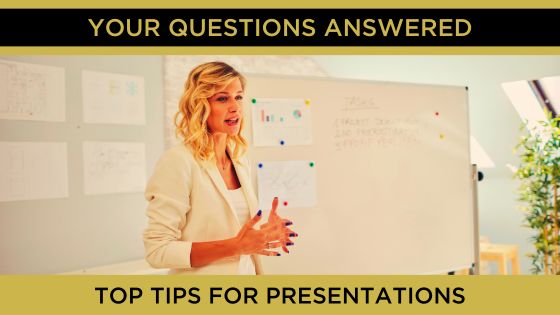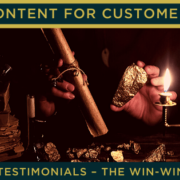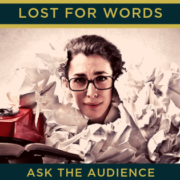Top tips for presentations
As a business owner you will probably need to make a presentation at some point. Whether for a business meeting, an opportunity to speak at an event or (most often) at a business networking meeting, that time will come when you need to stand up in front of a roomful of people and express yourself for 10, 15 or 20 minutes.
It is said that more people have a fear of public speaking than death – though I’m not sure when that research was done or how valid it is now. Whether true or apocryphal, knowing what to say and how to say it is one area where there is no reason to worry.
Here are my top tips for presentations from a content perspective:
Prepare your presentation in advance
As soon as you know you have a presentation coming up, set aside the time to prepare it. Nothing is likely to make you more anxious when facing the prospect of a presentation where you know it isn’t ready, or you haven’t given yourself enough time to get comfortable with the content.
Even if you are planning to repeat a presentation you’ve done before, this time it will be different. There will be a different audience, and things may have changed for you, for them, and for the wider world. You may have more or less time, so you’ll need to adapt to fit the new timings.
If you are giving a new presentation it can help to create a level map of key points, even starting by just brainstorming all the possible ideas you could include before winnowing them down. Only then do you go into more detail (you can even write a script if you like) and finally you can consider what props, aids, and tools you might want.
Know your Audience and outcome
This is the key factor as you are planning your presentation.
Who is in the room? Why are they there? What is the idea or concept you most want them to grasp?
I find the easiest way to get clear on this is to ask myself one simple question: “If my audience only walk away with one thing from my presentation, what is it?”
That helps me discard a lot of the ideas and possible topics I’d originally thought I’d include (and thus means I won’t waffle).
You know your stuff, they don’t!
In knowing your audience, it will help you pitch your presentation to the right level.
Think about what they already know and understand (which is often less than you might like to imagine) so you can be sure your content makes sense.
In preparing, this can sometimes mean you need to take the time to explain things which are obvious to you. As an example, I heard a builder recently explaining that DPC these days doesn’t need to be as deep as it used to be. Those who work in the construction industry were all nodding wisely, fascinated by what they were hearing. I felt lost! (It means ‘Damp Proof Course’ by the way).
Is your audience knowledgeable in your field?
Do you have a room full of novices?
Is it a mixture?
It is usually best to cut out any jargon, spell out acronyms, and assume at least one person in the room needs you to explain what you are talking about.
Also plan to go more slowly when presenting your material. You audience needs to digest your content, which means you need to give them more time and avoid trying to cram too much in. It comes back to that “one thing” question. If all you achieve is they understand the main point, you’ve done a good job. Some will take away more – and that’s a bonus. But the last thing you want is for people to walk away feeling they didn’t understand a thing!
Slides aid the audience (not you)
In your planning you may have written out a script to help you prepare. If you then decide to use slides to aide your presentation (and they are not obligatory, by the way) please do not transfer that script to the slides.
I see this all too often. A deck of slides goes up with a lot of bullet points, stuffed with words. Then the presenter simply reads them.
It’s deadly! Its boring! It keeps you locked to the slides with your back to the audience. And most people read faster than they listen, so they are already at the bottom of the slide before you are halfway through and now want you to get on with the next one.
Worse still, something packed with text comes up and the presenter says, “I don’t expect you to read this” (and then goes on to read it to you instead!).
Slides are only there to illustrate what you are saying, so use pictures and diagrams as much as possible and if you do need to use text limit it to one or two words for each idea.
I often use slide builds – one line or image at a time to build up the idea – but only do this if you have access to a remote control (aka ‘clicker’) to move the slides along and feel comfortable with the multitasking involved. And do please avoid getting over excited with slide animations. Words and images leaping out from the sides and bounding across the screen can be really distracting.
Rehearse till you are sick of it
You know what you are going to say and have materials assembled. Job done?
Not by a long chalk…
Now you need to practice. Even if you’ve presented this material before, and even if you are certain, you’ve got everything right, start running through the presentation.
It allows you to gauge for time, so you know you won’t get caught by a two-minute warning with 70% of the presentation still to go.
It means you can test that everything flows as you want it to, and you know how you will transition from one idea to the next.
It means you know the materials well enough that you don’t need to stay glued to your notes and can make eye contact with your audience.
Run it through a few times on your own and then, if you can, get a friend, colleague, or mentor to be a test audience for you too.
The more you practice, the less you will be worried about the content and that really brings down the nerves on the day.
Be ready for all the tech to fail
Have you asked yourself what you are going to do if your slides aren’t there for any reason. This usually comes down to a projector not being compatible with your laptop or the bulb going, but I’ve known for presentations to be scuppered by power cuts, a change of venue (so no one knew where anything was) and a previous tech delay resulting in the presentation time being halved at the last minute.
So, what is your backup plan?
Although I use my own PC when I can, I always also email my slides to the host and bring them on a USB drive. Plus, I know how I could manage if I had no slides at all. I also know someone who has a pocket projector which he can use if the in-house one fails for any reason.
If I’m reliant on images or diagrams for any reason, I have printed versions ready to pass round the room (not enough for one per person but enough that everyone can see in good time).
Technology will fail – so be ready for that to happen.
Don’t just read the script….
Remember what I said about reading your script from slides being boring?
The same applies to reading your script from a piece of paper when you come to present. Avoid it if at all possible.
If you’ve done enough rehearsal, you are going to know the overall shape and flow of what you plan to say, so you don’t need a script. Those who have the gift of a great memory can do without anything but their slides as a prompt (lucky them) but if not, create a list of the key points, to remind you what comes in what order.
I use small cards for this, with one or two points on each card and my logo on the back (looks really smart!), but one sheet of paper, a notebook, or even writing on your hand (if it will fit) will all work.
Then, most of your eye contact will be spent on the audience, not on the words on a page.
Breathe
Another advantage of index cards, is that at the bottom of each one, I write the word “Breathe!”
Presenting, even if you are experienced and enjoy it, generally leads to nerves. When we’re nervous, our breathing gets shallow, or we forget to breathe at all – and that tells your body there is danger around and it increases the fear response.
So, remember to take a few breaths, and pace yourself. Those short silences, which might feel like an eternity to you, will be comfortable to the audience. It gives them thinking time and time to process what you’ve already said, ready for the next point. And it can really add impact to a presentation as it can build suspense and make sure you have everyone’s attention.
Don’t forget a call to action
This is so important!
You’ve done the hard work in winning the audience, in sharing your story, getting your points across, building rapport…
So, now what? What’s the next step for them and for you?
This could be as simple as having a slide with your contact details at the end of the presentation so people can follow up but, the clever presenter has an offer ready.
You can give people discounted access to a course or a free taster session or assessment. You can tell them where you’re speaking next, so they can book in. You can even invite them to come and speak with you afterwards for more information.
But don’t miss this opportunity to take the audience beyond the presentation.
If you would like help creating the content for a presentation or would like to book Cate to speak on content, get in touch today.












Leave a Reply
Want to join the discussion?Feel free to contribute!